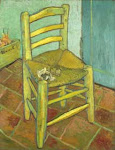
November 24th is the birthday of Henri-Marie-Raymond de Toulouse-Lautrec-Montfa (1864-1901), to my mind one of the most colorful figures in art history. Replicas of his famous poster designs for the Moulin Rouge and the Divan Japonais decorate many a kitchen or dorm room nowadays, and certainly his distinctive drawing style found admirers in his own time, including Vincent van Gogh.
Although they are grouped together in art history textbooks under the Post-Impressionist umbrella, most people might not realize van Gogh and Lautrec were very close friends. They must have made quite a pair in the Montmartre cafés and cabarets, the socially awkward Dutch preacher's son and the flamboyant, 4'11" son of aristocrats with his trademark bowler hat. They met in the studio of Fernand Cormon, where Lautrec was studying alongside artists like Émile Bernard when Vincent arrived in Paris in early 1886. The particulars of their friendship are not well documented in the surviving source material, but it seems Vincent introduced Lautrec to the influence of Japanese prints, while Lautrec helped bring Vincent into the avant-garde fold. Vincent invited Lautrec to exhibit in a group show he organized at the Restaurant du Chalet in 1887 and probably encouraged his brother Theo's purchase of Lautrec's painting Poudre de riz (Rice Powder, click image to enlarge) in January 1888. (This painting today is in the Van Gogh Museum, along with a pastel drawing Lautrec made of Vincent in a café.) Lautrec's painting of Mlle. Marie Dihau at a piano influenced Vincent's portrait of Marguerite Gachet at the piano in 1890 while at Auvers-sur-Oise. From model-painter Suzanne Valadon, who possibly posed for Poudre de riz, we learn Vincent was a frequent but shy guest at Lautrec's artist soirées; from Johanna van Gogh-Bonger, we learn the two friends last saw each other in early July 1890, when Vincent made his last trip to Paris from Auvers and a luncheon was held in Theo and Johanna's apartment.
My favorite van Gogh-Lautrec story centers on the exhibition of Les Vingt in Brussels in early 1890. Vincent showed six works (including two Sunflower canvases) but did not attend the opening, because he was at the hospital in Saint-Rémy at the time. Lautrec showed five works in the exhibition and did attend the inaugural dinner on 16 January. The Belgian painter Henry de Groux, drunk and disorderly, proceeded at the dinner to insult Vincent's paintings, referring to him as an 'ignoramus' and 'show-off.' The equally drunk Lautrec flew into a rage and insisted de Groux rescind his comments or face the consequences ... Lautrec's friends had to stop him from challenging de Groux to a duel over the matter. Eventually de Groux was made to apologize.
Unfortunately, any letters exchanged between Lautrec and van Gogh no longer exist. Three brief letters to Theo from Lautrec do survive, including a letter of consolation dated 31 July 1890, after Vincent's death. Lautrec did not learn of his friend's passing in time to attend the hasty funeral in Auvers. Lautrec writes, "You know what a friend he was to me and how eager he was to demonstrate his affection -- unhappily, I am only able to tell you all this by clasping your hand very warmly but in the presence of a coffin."* Lautrec would die at nearly the same age as Vincent, just shy of thirty-seven, eleven years later in 1901.
*Trans. in R. Pickvance, ed., "A Great Artist is Dead: Letters of Consolation on Vincent van Gogh's Death" (Van Gogh Museum, 1992).








